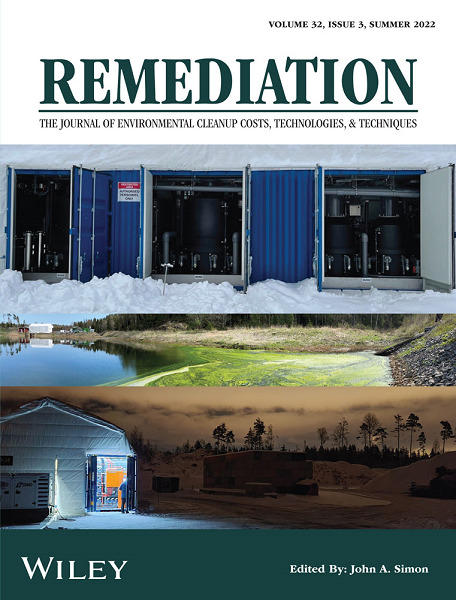 A recent paper entitled “Enhanced attenuation (EA) to manage PFAS plumes in groundwater”, authored by a very credible group of individuals from GSI Environmental and recently published on the REMEDIATION Journal website (the article is open access, meaning anyone can access it for free, and it is to be included in the Fall publication of REMEDIATION Journal). This paper follows two other publications by the same group1, 2 that were supported by ESTCP funding which set the groundwork for the technical argument supporting the use of natural attenuation as a remedial strategy for treating PFAS in groundwater.
A recent paper entitled “Enhanced attenuation (EA) to manage PFAS plumes in groundwater”, authored by a very credible group of individuals from GSI Environmental and recently published on the REMEDIATION Journal website (the article is open access, meaning anyone can access it for free, and it is to be included in the Fall publication of REMEDIATION Journal). This paper follows two other publications by the same group1, 2 that were supported by ESTCP funding which set the groundwork for the technical argument supporting the use of natural attenuation as a remedial strategy for treating PFAS in groundwater.
Key takeaways:
- Enhancing PFAS retention can play a key role in reducing mass This can result in the following plume management benefits:
- Plume Retention processes can slow the migration of PFAS extending the time before a plume impacts a receptor.
- Peak shaving or Peak Some retention processes can result in the blunting of a short-term, high mass discharge plume, converting it to a longer term but low mass discharge plume. In this case, the peak concentration of PFAS in water is decreased due to the rate of adsorption being faster than the rate of desorption. (See Figure 3 in the paper for a visualization of this.)
- Plume At some sites, increasing PFAS retention along with dispersion may be enough to stabilize a plume and prevent further expansion.
- Plume If the source has been removed and the plume stabilized, over time it may shrink.
- Eight Methods to Enhance Retention of PFAS are reviewed or hypothesized:
- Injection of particulate This is a direct acknowledgement of REGENESIS’ success at using PlumeStop®to treat PFAS plumes and is mentioned as currently being practiced. This method is noted as having among the highest retention and in current practice.
- Capping of source This is cited as a method to retain PFAS mass in the vadose zone.
- Gas This is a hypothesized method of concentrating PFAS at the groundwater table in an effort to retain PFAS.
- Salting out This again is a hypothesized method of adding ionic strength to reduce the solubility of PFAS.
- Placement of vertical columns of sorbent. Use of heavy geotechnical equipment to drive or drill borings that are then filled with slurry of
- Emplacement of oil at groundwater This hypothesized approach would collect PFAS at the water table in an LNAPL of food grade oil.
- Use of emulsified vegetable oil to enhance Injection of emulsified oil to keep an aquifer anaerobic and limit aerobic biotransformation of precursors, and offer added retention of PFAS similar to a sorbent.
- PFAS discharge to surface water+ This hypothesized approach is to build walls to funnel all migrating PFAS in groundwater to surface water, then sparge water to collect PFAS in oil layer.
Summary
This paper acknowledges that the injection of sorbents can result in high PFAS retention and reduction in mass flux. The paper points out that such retention of PFAS “fits directly into the enhanced attenuation framework, an established groundwater remediation strategy that was developed in the first decade of the 2000s for other groundwater contaminants”. This enhanced retention, particularly in combination with source capping or removal, can result in plume retardation, plume stabilization and plume shrinking.
Among the eight methods cited to enhance natural attenuation through PFAS retention, only the injection of particulate sorbents (PlumeStop) is noted as increasing the retention of PFAS and currently being practiced. Capping of the source zone is the only other method currently being implemented at PFAS sites, while the other six are unverified, early-stage concepts.
1 Newell, C.J., Adamson, D.T., Kulkarni, P.R., Nzeribe, B. N., Connor J. A., Popovic, J., & Stroo, H. F. (2021). Monitored natural attenuation to manage PFAS impacts to groundwater: Scientific basis. Groundwater Monitoring& Remediation, 41(4), 76-89. https://doi.org/10.1111/gwmr.12486
2 Newell, C.J., Adamson, D.T., Kulkarni, P.R., Nzeribe, B.N., Connor, J.A., Popvic, J., & Stroo, H. F. (2021). Monitored natural attenuation to manage PLFAS impacts to groundwater: Potential guidelines. Remediation Journal, n/a, 31, 7-17. https://doi.org/10.1002/rem.21679


 Americas
Americas Europe
Europe Français
Français Deutsch
Deutsch Italiano
Italiano Español
Español


